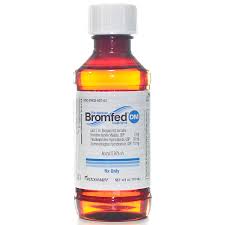Bromfed is a medication that is used to relieve coughing, cold and nasal problems, but why was bromfed discontinued?
Quick Facts About Bromfed
| A | B |
|---|---|
| Generic Name | Brompheniramine, dextromethorphan, and pseudoephedrine |
| Brand Name(s) | Bromfed DM, Allanhist PDX Drops, Anaplex DM, Andehist DM NR Syrup, Bromaline DM, Lodrane D |
| Drug Class | Upper respiratory combinations |
| Uses | Treats cough, runny/stuffy nose, sneezing, itching, and watery eyes caused by allergies, cold, or flu |
| Not For | Cough caused by smoking, asthma, or emphysema |
| How It Works | Antihistamine (Brompheniramine), Cough suppressant (Dextromethorphan), Decongestant (Pseudoephedrine) |
| Dosage Form | Syrup |
| Color | Pink |
| Dosage | Adults and children 12 years and over: 2 teaspoonfuls every 4 hours |
| Controlled Substance Classification | Not a controlled substance |
| Side Effects | May include dizziness, drowsiness, dry mouth/nose/throat, headache, upset stomach |
| Precaution | Avoid MAO inhibitors, consult doctor if pregnant/breastfeeding, use caution in certain medical conditions |
| Interactions | May interact with MAO inhibitors and other drugs |
| Administration | Orally, with or without food |
| Availability | Prescription only |
| Storage | Store at room temperature in a dry place. Keep out of reach of children and pets |
| Pregnancy Category | Category C (US) - Risk cannot be ruled out |
| Breastfeeding | Can pass into breast milk and may harm a nursing baby; may also slow breast milk production |
Healthsoothe’s article today aims to answer the question above; “Why was bromfed discontinued?” If you have been looking for the answer to this question, then you are in the right place.
We have gone around and asked various health professionals whose field of operation is related to drugs.
To tell or show how serious we are about finding key and factual details, we actually asked a pharmaceutical scientist, a clinical pharmacist, and a drug researcher, so as to know all we can on the issue of “why was bromfed discontinued?”
We will analyze the crucial things you have to know about bromfed, so you can see or read for yourself why was bromfed discontinued.
Quite funny, but let me ask this; has bromfed really been discontinued or just strictly controlled? Find out the answer to this and get the truth on the issue of “why was bromfed discontinued?”
Firstly, let’s discuss Bromfed?

Bromfed is a combination of three medications (brompheniramine, dextromethorphan, and pseudoephedrine) that work together to relieve the nasal symptoms and coughing caused by allergies or the common cold.
Its three main constituents each have their own work;
- Brompheniramine acts as an antihistamine that reduces inflammation caused by cold or allergies.
- Dextromethorphan acts as a cough suppressant that lowers your cough urges.
- Pseudoephedrine acts as a decongestant that clears your sinuses.
But why was Bromfed discontinued? To answer this question, we need to get an idea of other things about bromfed like its uses, side effects, and drug interactions, as well as other crucial things to know.
Then on knowing these things, you will now have an idea of why was bromfed discontinued, or even know exactly why was bromfed discontinued.
Uses of Bromfed
Bromfed is used to treat the following;
- Sneezing
- Watery or itchy eyes
- Runny nose
- Certain allergies of the upper respiratory tract or passage
- Common cold
- Allergic rhinitis (Hay fever)
- Sinusitis
- Itchy throat or nose
- Cough (minor bronchial and throat irritation)
- Nasal congestion (swelling of the nasal tract or passage)
Side effects of Bromfed
Common side effects;
- Anxiousness
- Unusual fatigue and tiredness
- Sleepiness
- Dry mouth, nose, or throat
- Hypertension/hypotension
- Dizziness
- Thicker mucus
- Other side effects
- Feeling restless
- Headache
The above side effects may get better over time as your body gets used to the medication. Let your doctor know immediately if you continue to experience these symptoms or if they worsen over time.
Serious side effects;
- Difficult urination
- Allergic reactions (skin rash, itching or hives, swelling of the face, lips, or tongue)
- Excessive sleepiness or dizziness
- Hypertension
- Tachycardia (increased heartbeat)
- Hallucinations, loss of consciousness (signs of an overdose), and seizures
- Serotonin syndrome (confusion, seizures, vomiting, difficulties in walking, chills, twitching muscles, sweating, high fever, diarrhea, stiff muscles, and irregular or fast heartbeats)
Contact your doctor immediately if you experience any of the above.
Drug interactions of Bromfed
Before using any other cough or cold medications that may contain comparable chemicals, consult your doctor or pharmacist.
Avoid driving or engaging in risky activities until you know how this medication may affect you. Your responses may be hampered.
During activity especially in hot conditions, avoid being overheated or dehydrated. Because this medication reduces sweating, you may be more susceptible to heat stroke.
Drinking alcohol while taking this medication may result in negative effects.
What will happen if I miss significant doses of Bromfed and what do I do?
Nothing much will happen. Just that if you have missed significant doses of the drug, it will not be effective or potent enough to treat you for the ailment you took it for.
Do the following if you have missed dose on significant doses;
- If you forget to take one or more doses; take your next dose at the usual time and in the average amount. Do not take anymore than your doctor prescribed.
- If you miss one dose, skip it and continue with your normal schedule.
- Do not increase the dosage to catch up with the missed doses.
- You should consult your doctor on what to do if you don’t know what to do.
What will happen if you overdose on Bromfed and what do I do?
Overdose symptoms can lead to severe side effects - See the serious side effects section in this article; which includes the feeling of depression or restlessness, fast or irregular heartbeats, severe drowsiness, loss of coordination and consciousness, or seizure, and others that are even more devastating and fatal.
If you think there has been an overdose, call your healthcare provider, poison center, or doctor immediately or get medical care right away. Be ready to tell or show what was taken, how much, and when it happened.
Why was Bromfed discontinued? - Know the Truth

So now, why was bromfed discontinued? Bromfed is now considered obsolete, but the truth is that it is still available, but it is now regulated very strictly and under very tight control by drug regulatory bodies.
So, why is bromfed now tightly controlled? This is because it contains pseudoephedrine, a sought-after ingredient for the illicit manufacture of methamphetamine (a drug that drug addicts or hard-drug users use illicitly to get pseudo-high, but the drug really affects the brain and other adverse health effects).
Methamphetamine (meth) is a highly addictive and illegal psycho-stimulant drug that is similar to amphetamine.
It is used for its powerful euphoric effects, which are similar to those of cocaine, but this drug like many hard drugs can cause devastating and even fatal side effects.
This is why bromfed is not tightly controlled because one of its ingredients – pseudoephedrine is used to produce meth by mixing other substances with it to induce a reaction that produces one to three grams of meth.
Illicitly manufactured meth is usually made by combining ephedrine or pseudoephedrine with other chemicals that are often poisonous or highly flammable. The mixture is then added to a solvent such as gasoline and heated to crystallize. Because illicit methamphetamine production is not regulated or supervised, and there is no quality control process, any number of cutting agents could conceivably be added to the process to dilute the drug.
The heating process is particularly dangerous, as there is a significant risk of fire and explosion. The waste materials left behind are also highly unstable and combustible. According to the U.S. Forest Service, 1 pound of meth produces up to 6 pounds of toxic waste.
There are many detrimental health effects associated with operating a meth lab. Inhaling fumes during methamphetamine production can cause significant lung damage and other respiratory issues while handling the various corrosive or poisonous chemicals that can damage the skin and eyes.
See the following to find out how devastating meth, is and the reasons this warrants the obsolete availability of bromfed;
Methamphetamine (meth) can make a user's body temperature rise so high they could pass out or even die.
A user may feel anxious and confused, be unable to sleep, have mood swings, and become violent.
Looks can negatively change dramatically. A user may age quickly. Their skin may dull, and they can develop hard-to-heal sores and pimples. They may have a dry mouth and stained, broken, or rotting teeth. Know the effects of meth on your mouth. Meth can also affect the heart. Ongoing meth use may also lead to lung damage.
They may become paranoid. They may hear and see things that aren’t there. They may think about hurting themselves or others. They may also feel as though insects are crawling on or under their skin.
A meth user is at higher risk for HIV/AIDS. The drug can affect judgment and lessen inhibitions. Someone under the influence of the drug may be more likely to engage in risky behaviors, such as unsafe sex.
Methamphetamine is neurotoxic and can damage dopamine and serotonin neurons in the brain leading to brain problems.
Most methamphetamine is made illegally, and it may contain caffeine, talc, and other toxic substances that lead to cardiovascular, liver, and kidney damage.
Studies suggest that it may lead to structural and functional changes in the brain associated with emotion and memory and that some of these may be irreversible.
Toxicity increases when used with alcohol, cocaine, or opiates.
A lot of people die of meth overdose in the U.S.
Long-term methamphetamine abuse has many negative consequences, including addiction and it is very difficult to quit (has a lot of withdrawal problems).
So on reading all these above, you should now understand better the issue of why was bromfed discontinued.
What are health bodies/agencies concerning drugs like the FDA saying on the issue of “why was bromfed discontinued?”
We have already established why bromfed seems obsolete. To recap, it is because one of its constituents is used to produce meth, and this is a big no-no for FDA and other drug bodies.
So now what are drug bodies like FDA saying on this issue of “why was bromfed discontinued?”
The United States Drug Enforcement Administration (DEA) still recognizes that methamphetamine has medicinal value, although it is an extremely dangerous drug. It is classified as a Schedule II controlled substance, indicating that methamphetamine has some medical utility, but also significant potential for abuse and is very likely to produce physical dependence in people who use it over time. Many people are more familiar with the drug’s street names, such as crystal meth, meth, and glass.
Currently, most methamphetamine in the United States is produced by transnational criminal organizations (TCOs) in Mexico. This methamphetamine is highly pure, potent, and low in price. The drug can be easily made in small clandestine laboratories, with relatively inexpensive over-the-counter ingredients such as pseudoephedrine, a common ingredient in cold medications.
To curb the production of methamphetamine, Congress passed the Combat Methamphetamine Epidemic Act in 2005, which requires that pharmacies and other retail stores keep logs of purchases of products containing pseudoephedrine and limits the amount of those products an individual can purchase per day. Restrictions on the chemicals used to make methamphetamine in the United States have dramatically reduced domestic production of the drug. In 2010, there were 15,256 domestic methamphetamine laboratory incidents—a figure that has fallen over 80 percent to 3,036 in 2017. Data on drug seizures indicate that most domestic production of methamphetamine is now conducted in small laboratories that make two ounces or less of the drug using common household items.
Mexico has also tightened its restrictions on pseudoephedrine and other methamphetamine precursor chemicals. But manufacturers adapt to these restrictions via small- or large-scale "smurfing" operations: obtaining pseudoephedrine from multiple sources, below the legal thresholds, using multiple false identifications. Manufacturers in Mexico are also increasingly using a different production process (called P2P which stands for pseudoephedrine’s precursor chemical, phenyl-2-propanone) to make methamphetamine that does not require pseudoephedrine.
When methamphetamine is smuggled into the United States in powder or liquid form, domestic conversion laboratories transform it into crystal methamphetamine. These laboratories do not require a significant amount of equipment, so they can be small in size and thus easily concealed, which presents challenges to law enforcement agencies. Methamphetamine pressed into a pill form intended to resemble ecstasy has also recently emerged, potentially in an effort to make methamphetamine more appealing to people who haven’t tried it before.44 As with other illicit drugs like heroin and cocaine, methamphetamine is also sometimes laced with fentanyl.
Methamphetamine production is also an environmental concern; it involves many easily obtained chemicals that are hazardous, such as acetone, anhydrous ammonia (fertilizer), ether, red phosphorus, and lithium. Toxicity from these chemicals can remain in the environment around a methamphetamine production lab long after the lab has been shut down, causing a wide range of damaging effects on health. Because of these dangers, the U.S. Environmental Protection Agency has provided guidance on the cleanup and remediation of methamphetamine labs.
So on reading all these above, you should now understand better the issue of why was bromfed discontinued or why it seems obsolete.
You should now know why it is now tightly controlled. It is only available through a doctor’s prescription, and even this only happens when your doctor can vouch strongly that you won’t misuse the drug, and he/she will strictly supervise you.
And of course, the bromfed is only prescribed to you if the benefits outweigh the side effects.
Is Bromfed available over-the-counter (OTC)?
Bromfed DM is only available on a prescription from your doctor, not OTC. This is because it contains pseudoephedrine, a sought-after ingredient for the illicit manufacture of methamphetamine (a drug that drug addicts or hard-drug users use illicitly to get pseudo-high, but the drug affects the brain and other adverse health effects).
Better and safer alternatives to Bromfed
Alternative, safer and better medications are available for use since bromfed seems obsolete, and any slight misuse of it is not good. So instead of going ahead with it, you can the following alternatives to bromfed;
- Zutripro
- Tessalon
- Benzonatate
- Cheratussin AC
- Guaiatussin AC
- Guaifenesin/codeine
- Virtussin AC
- Promethazine DM
- Promethazine/codeine
- Hydromet
- Hydrocodone / Homatropine
- Hydrocodone / Chlorpheniramine
- Hycodan
Healthsoothe’s advice on the issue of “why was bromfed discontinued?”
Frankly, this deserves a thorough ban of bromfed since people will still misuse it no matter how strictly controlled it is. Other alternatives, safe and better medications are available for use, since bromfed availability is close to obsolete, and even the slightest misuse of bromfed can lead to major side effects.
But if you still insist on using bromfed or that’s what your doctor prescribed for you, then you have to be careful. Take the drug as prescribed, find out the possible drug interactions to avoid, and make sure not to misuse or even overdose the slightest on bromfed.
Do not use bromfed if it wasn’t prescribed for you, and make sure not to buy it from unauthentic sources, because you might end up purchasing hard drugs like meth, and trust me, that’s a big no-no for your health.
Please be informed. Our health is not to be trifled with. Bad health is bad for business, whereas good health keeps you on the go.
So please dear readers, always be careful about your health, and always make sure to get the go-ahead from a professional medical doctor before engaging in certain medications so as not to regret it later.
You can always check our FAQs section below to know more about the issue of “why was bromfed discontinued?”
Frequently Asked Questions on the issue of “why was bromfed discontinued?”
What is the over-the-counter version of Bromfed?
Brompheniramine/dextromethorphan/pseudoephedrine is an OTC medication used to treat nasal congestion and cough. Brompheniramine/dextromethorphan/pseudoephedrine is marketed under many brand names like Bromfed-DM.
Are Dimetapp and Bromfed the same?
Yes, since bromfed includes brompheniramine, a first-generation antihistamine medication of the propylamine (alkylamine) type that is commercialized under the trade name Dimetapp among others. It is used to treat the common cold and allergic rhinitis symptoms such as runny nose, itchy eyes, watery eyes, and sneezing.
Is codeine syrup the same thing as Bromfed Cough Syrup?
No. Codeine is an opioid that is occasionally used as a cough suppressant in cough syrups. Bromfed Cough Syrup is free of opiates, including codeine.
Where can I buy bromfed?
You can only buy it via a doctor’s prescription at a hospital or pharmacy.

